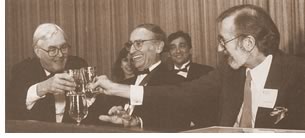

1927-2003
Profession mourns the loss of a champion and true friend
 Daniel
Patrick Moynihan (D-N.Y.), U.S. Ambassador to the United Nations, U.S.
Ambassador to India, Harvard professor, and four-term U.S. Senator from
New York, died March 26 in Washington, D.C., at the age of 76. He will
be remembered across the nation as a scholar of razor-sharp wit and politician
of great skill whose legacy will continue in perpetuity through his words,
eloquently spoken and exquisitely written. But for many, our profession
certainly among them, Moynihan’s spirit lives on most vibrantly
in the built environment—from single structure to cityscape to transportation
plans—for which he treasured and championed excellence.
Daniel
Patrick Moynihan (D-N.Y.), U.S. Ambassador to the United Nations, U.S.
Ambassador to India, Harvard professor, and four-term U.S. Senator from
New York, died March 26 in Washington, D.C., at the age of 76. He will
be remembered across the nation as a scholar of razor-sharp wit and politician
of great skill whose legacy will continue in perpetuity through his words,
eloquently spoken and exquisitely written. But for many, our profession
certainly among them, Moynihan’s spirit lives on most vibrantly
in the built environment—from single structure to cityscape to transportation
plans—for which he treasured and championed excellence.
As Washington Post architecture critic Benjamin Forgey points out in a March 27 tribute to Moynihan, “his interest in cities and architecture was a constant theme. Early on, he became absorbed with the idea of using political power to get things built, and to make sure that what did get built in the name of all of us was as good as it could possibly be. Conversely, when a good building was threatened with destruction and he could do something about it, he did.”
In his home state of New York, Moynihan guided such projects as the long-standing and ongoing revitalization of New York City’s Penn Station and the U.S. Customs House in Battery Park City. In Buffalo, he saved Louis Sullivan's 1896 Guaranty Building—the 13-story-tall terra-cotta poem to early skyscrapers—from slated demolition in 1977, secured loans for its restoration, and moved his upstate headquarters into the building.
Standards for excellence
Fittingly, though, Moynihan's interest in and concern for good architecture
manifests itself most plainly in a swath of road in the nation’s
capital that has been called “America’s Main Street.”
Pennsylvania Avenue between the U.S. Capitol and the White House has been
under the revitalization spell of the “Guiding Principles of Federal
Architecture” penned by Assistant Labor Secretary Moynihan in the
early 1960s. "The belief that good design is optional, or in some
way separate from the question of the provision of office space itself,
does not bear scrutiny." And even more lyric to the architect’s
ear, “Design must flow from the architectural profession to the
government, and not vice versa.”
Forerunner to the U.S. General Services Administration’s present-day Design Excellence program, Moynihan’s guidelines for 40 years have shaped thinking about federal building design as well as the development of Pennsylvania Avenue, culminating in the completion of the city’s Federal Triangle with Pei Cobb Freed’s Ronald Reagan Building and International Trade Center in 1996.
It was in the Reagan Building, the day after Moynihan’s death, that the GSA gathered to celebrate the winners of its biennial Design Awards program. AIA President Thompson E. Penney, FAIA, one of the program’s speakers, asked to depart from prepared remarks “to acknowledge the contributions of the late and much beloved Senator David Patrick Moynihan.” Penney said, “His leadership and insights were the driving force in so many arenas, most especially his commitment to making our public buildings a proud symbol and enduring legacy of our democracy.”
 Honored
by the Institute
Honored
by the Institute
Over the years, the AIA presented Moynihan with some of its finest accolades.
The Institute tapped the Senator for Honorary Membership in 1984. With
Architect of the Capitol George White, FAIA, and Pei Cobb Freed’s
James Ingo Freed, FAIA, he was the recipient of the AIA’s first
Thomas Jefferson Award in 1992, which honors preeminent champions of public
architecture. Last
December, when the GSA honored Moynihan for the influence of his thought
on federal architecture for the past 40 years, the AIA was proud to pay
him homage.
Moynihan, according to accounts, liked to quote Thomas Jefferson as saying
“Design activity and political thought are indivisible.” Our
capital city, and our profession, have been built on Jefferson’s
words and reinforced by those of Moynihan. “Today, we lost more
than ‘The Gentleman from New York,’ we lost one of the greatest
minds of our times. He was our Jefferson, our Lincoln,” said Sen.
Hillary Rodham Clinton, who now holds Moynihan's seat, when she announced
his death to the Senate. “He was New York's architect of hope. He
devoted more than 50 years of his life to public service in order to build
a better world.”
Copyright 2003 The American Institute of Architects.
All rights reserved. Home Page ![]()
![]()
 |
||
| Senator Moynihan toasts the third President of the United States upon receiving the first Thomas Jefferson Award from the AIA in 1992. The award goblet that he holds is a pewter reproduction of a Jefferson design. Winners of the first AIA Thomas Jefferson Award (left to right): Moynihan; Architect of the Capitol George White, FAIA; and James Ingo Freed, FAIA; celebrated their honor at the 1992 Grassroots Leadership Conference. Photos by Mike Gessinger.
|
||